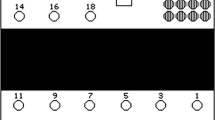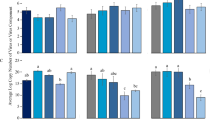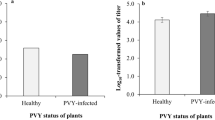Abstract
The transmission characteristics of members of the genus Allexivirus to leek (Allium porrum L.) by its eriophyid mite vector, Aceria tulipae (Keifer), were studied. Prior to conducting transmission tests, colonies of nonviruliferous A. tulipae were established on healthy leek seedlings. A single A. tulipae transmitted the viruses with up to 50% efficiency but transmission efficiency increased when >10 mites per plant were used. Allexiviruses were acquired by A. tulipae after a minimum acquisition access period (AAP) of 30 min, whereas transmission tests suggest that a one hour inoculation access period (IAP) was needed for successful transmission. Allexiviruses were transmitted from garlic to leek plants by A. tulipae and mixed infections by more than one virus were observed. ShVX, GarV-A, -C, -D, and -B were detected in most inoculated plants, whereas other members of the genus (GarV-E, −X, and GarMbFV) were found only occasionally. None of the mites that originated from eggs deposited on infected plants transmitted allexiviruses, indicating that the viruses are not transmitted transovarially. No latent period was demonstrated. Taken together, these data suggest a semipersistent mode of transmission of Allexivirus members by A. tulipae. The output of this study will assist in the better management of the vector and the associated diseases.
Similar content being viewed by others

References
Adams, M. J., Candresse, T., Hammond, J., Kreuze, J. F., Martelli, G. P., Namba, S., Pearson, M. N., Ryu, K. H., & Vaira, A. M. (2012). Alphaflexiviridae. In a.M. Q. King, M. J. Adams, E. B. Carstens, & E. J. Lefkowitz (Eds.), virus taxonomy, classification and nomenclature of viruses. Ninth report of the international committee on taxonomy of viruses. Amsterdam: Elsevier academic press.
Ahmed, K. M., & Benigno, D. A. (1984). Control of the eriophid mite Aceria tulipae Keifer, the cause of tangle-top malady and the vector of garlic mosaic virus. Indian Journal of Plant Protection, 12, 153–154.
Bampi, D., Reinsel, M. D., & Hammond, J. (2015). Viruses present in ornamental Allium in the United States. In: Proceedings of the APS annual meeting 1st-5th august, Pasadena, California, USA, 513.
Beltran, M. J. B. (2020). Preliminary sampling of dry bulb mite, Aceria tulipae Keifer in native garlic in Ilocos region, Luzon Island, Philippines. Archives of Phytopathology and Plant Protection, 53, 653–658.
Bhat A. I., & Rao G. P. (2020). Transmission of viruses through mites. In: Characterization of Plant Viruses. Springer Protocols Handbooks. Humana, New York, NY.
Budai, C. S., Regos, A., & Szeredi, A. (1997). The occurrence of onion leaf mite (Aceria tulipae Keifer) in garlic bulbs. Novenyvedelem, 33, 53–56.
Cafrune, E. E., Perotto, M. C., & Conci, V. C. (2006). Effect of two Allexivirus isolates on garlic yield. Plant Disease, 90, 898–904.
Chen, J., Zheng, H. Y., Antoniw, J. F., Adams, M. J., Chen, J. P., & Lin, L. (2004). Detection and classification of allexiviruses from garlic in China. Archives of Virology, 149, 435–444.
Celli, M. G., Perotto, M. C., Buraschi, D., & Conci, V. C. (2016). Biological and molecular characterization of garlic virus D and its effects on yields of garlic. Acta Horticulturae, 1143, 193–200.
Chodorska, M., Paduch-Cichal, E., Kalinowska, E., & Szyndel, M. S. (2014). Assessment of Allexiviruses Infection in Garlic Plants in Poland. Acta Sci. Pol., HortorumCultus, 13, 179–186.
Conci, V. C., Lunello, P., Buraschi, D., Italia, R. R., & Nome, S. F. (2002). Variations of Leek yellow stripe virus concentration in garlic and its incidence in Argentina. Plant Disease, 86, 1085–1088.
Conci, V. C., Canavelli, A., Lunello, P., Di Rienzo, J., Nome, S. F., Zumelzu, G., & Italia, R. (2003). Yield losses associated with virus-infected garlic plants during five successive years. Plant Disease, 87, 1411–1415.
Courtin, O., Fauvel, G., & Leclant, F. (2000). Temperature and relative humidity effects on egg and nymphal development of Aceria tulipae (K.) (Acari: Eriophyidae) on garlic leaves (Allium sativum L.). Annals of Applied Biology, 137, 207–211.
Dąbrowska, E., Lewandowski, M., Koczkodaj, S., & Paduch-Cichal, E. (2020). Transmission of Garlic virus B, Garlic virus C, Garlic virus D and Garlic virus X by Aceria tulipae (Keifer) in leek. European Journal of Plant Pathology, 157, 215–222.
Debnath, P., & Karmakar, K. (2013). Garlic mite, Aceria Tulipae (Keifer) (Acari: Eriophyoidea) – A threat for garlic in West Bengal, India. International Journal of Acarology, 39, 89–96.
Gispert, C., Oldfield, G. N., Perring, T. M., & Creamer, R. (1998). Biology of the transmission of peach mosaic virus by Eriophyes insidiosus (Acari: Eriophyidae). Plant Disease, 82, 1371–1374.
Karpicka-Ignatowska, K., Laska, A., Kuczyński, L., Rector, B. G., Lewandowski, M., Puchalska, E., & Skoracka, A. (2019). A novel experimental approach for studying life-history traits of phytophagous arthropods utilizing an artificial culture medium. Scientific Reports, 9, 1–9.
Keifer, H. H. (1952). The eriophyid mites of California (Acarina: Eriophyidae). Bulletin of the California Insect Survey, 2, 1–123.
Kiedrowicz, A., Szydło, W., & Skoracka, A. (2017). Population growth rate of dry bulb mite, Aceria tulipae (Acariformes: Eriophyidae), on agriculturally important plants and implications for its taxonomic status. Experimental and Applied Acarology, 73, 1–10.
Knoell, E. A. (2018). Transmission characteristics of Triticum mosaic virus by the wheat curl mite Aceria tosichella Keifer and ecology of the wheat-mite-virus complex on field corn. Dissertations and Student Research in Entomology University of Nebraska-Lincoln.
Kulkarni, N. K., Kumar, P. L., Muniyappa, V., Jones, A. T., & Reddy, D. V. R. (2002). Transmission of pigeon pea sterility mosaic virus by the Eriophyid mite, Aceria cajani (Acari: Arthropoda). Plant Disease, 86, 1297–1302.
Manson, D. C. M. & Oldfield G. N. (1996). Life forms, deuterogyny, diapause and seasonal development. In: Lindquist, E.E., Sabelis, M.W. & Bruin, J. (eds.) Eriophyoid mites - their biology, natural enemies and control. World crop pests Vol 6. Elsevier Science Publishing, Amsterdam, 173–183.
Murashige, T., & Skoog, F. (1962). A revised medium for rapid growth and bioassays with tobacco tissue cultures. Physiologia Plantarum, 15, 473–497.
Orlob, G. B. (1966). Feeding and transmission characteristics of Aceria tulipae Keifer as vector of Wheat Streak Mosaic Virus. Journal of Phytopathology, 55, 218–238.
Paduch-Cichal, E., & Bereda, M. (2017). Viruses infecting ornamental Allium species in Poland. Journal of Plant Pathology, 99, 509–512.
Park, K. S., Bae, Y. J., Jung, E. J., & Kang, S. J. (2005). RT-PCR-based detection of six garlic viruses and their phylogenetic relationships. Journal of Microbiology and Biotechnology, 15, 1110–1114.
Sánchez-Sánchez, H., Henry, M., Cárdenas-Soriano, E., & Alvizo-Villasana, H. F. (2001). Identification of Wheat streak mosaic virus and its vector Aceria tosichella in Mexico. Plant Disease, 85, 13–17.
Sapáková, E., Hasíková, L., Hřivna, L., Stavělíková, H., & Šefrová, H. (2012). Infestation of different garlic varieties by dry bulb mite Aceria tulipae (Keifer) (Acari: Eriophyidae). Acta Universitatis Agriculturae et Silviculturae Mendelianae Brunensis, 60, 293–301.
Seifers, D. L., Harvey, T. L., Louie, R., Gordon, D. T., & Martin, T. J. (2002). Differential transmission of isolates of the High Plains virus by different sources of wheat curl mites. Plant Disease, 86, 138–142.
Stenger, D. C., Hein, G. L., Tatineni, S., & French, R. (2016). Eriophyid mite vectors of plant viruses. Chapter 18, 263-274. In: Vector-mediated transmission of plant pathogens. Brown, J. K. (ed.), APS press.
Van Dijk, P., Verbeek, M., & Bos, L. (1991). Mite-borne virus isolates from cultivated Allium species, and their classification into two new rymoviruses in the family Potyviridae. European Journal of Plant Pathology, 97, 381–399.
Acknowledgments
The project was supported by the internal Grant Agency of the Czech University of Life Sciences Prague (CIGA) (Project No. 20182014) in the Czech Republic and PROM (International Scholarship Exchange of PhD Candidates and Academic Staff)/ NAWA (Polish National Agency for Academic Exchange), Warsaw University of Life Sciences.
Author information
Authors and Affiliations
Corresponding author
Ethics declarations
The research does not involve any human participants and/or animals. The materials in the article have not been published in whole or in part elsewhere and not currently being considered for publication in another journal. All authors have been personally and actively involved in substantive work leading to the manuscript and will hold themselves jointly and individually responsible for its content. The authors certify that the work carried out in this research followed the principles of ethical and professional conduct. All authors consent to this submission.
Conflict of interest
The authors declare that they have no conflict of interest.
Rights and permissions
About this article
Cite this article
Mansouri, F., Richert-Pöggeler, K.R., Lewandowski, M. et al. Transmission characteristics of allexiviruses by the eriophyid mite, Aceria tulipae (Keifer) (Acari: Eriophyidae) from naturally mixed infected garlic (Allium sativum L.). Eur J Plant Pathol 160, 789–796 (2021). https://doi.org/10.1007/s10658-021-02281-0
Accepted:
Published:
Issue Date:
DOI: https://doi.org/10.1007/s10658-021-02281-0



